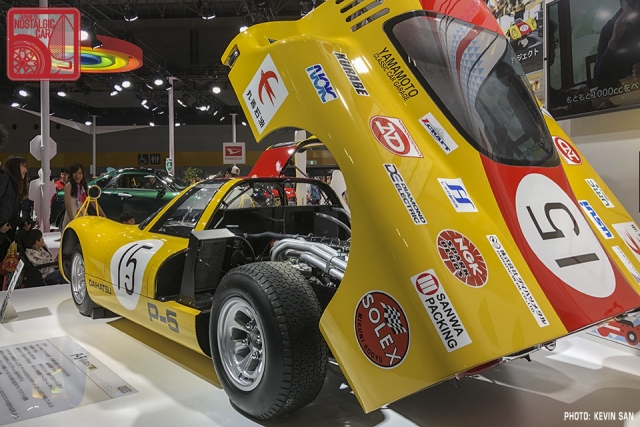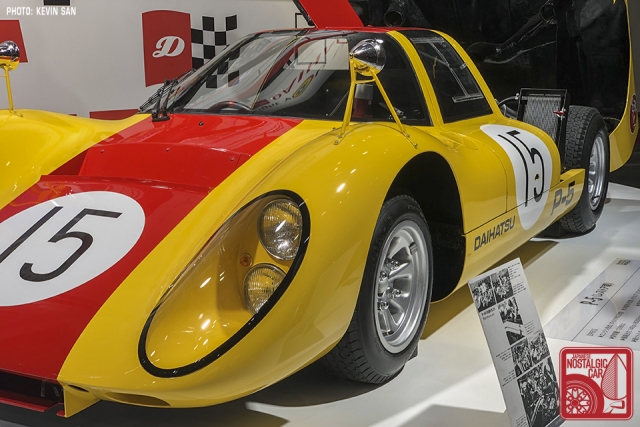These days Daihatsu is doing brisk business manufacturing an endless variety of kei cars as a Toyota subsidiary. It doesn’t have any presence to speak of in the world of motorsports today, but in the wild west of 1960s Japan, the company built and ran a full-on race car. The 1967 Daihatsu P-5 has been making the rounds at shows like the Tokyo Auto Salon and Osaka Auto Messe, having recently emerged from a restoration that spanned over ten years.
Back in the 1960s, Daihatsu built at least four P-5 race cars. The mid-engined, fiberglass-bodied race car was entered into the 1967 Japan Grand Prix, appearing on the same grid as cars like the Toyota 7, Nissan R380, and Porsche 906. However, while those cars’ engines ranged from 2.0 to 7.0 liters, Daihatsu’s motor displaced a mere 1.3.
Daihatsu had been an engine maker first, before delving into the carmaking business, and knew how to build a motor. Despite its small size and origins as a Daihatsu Compagno one-liter, the inline-four sported twin overhead cams, four valves per cylinder, dual Mikuni 50 PHH carbs, and generated an astonishing 140 horsepower — an amazing 108 horsepower per liter. It is said that the top speed was an impressive 150 mph, and that the redline was 10,000 rpm.
While Japan’s automakers were creating ever more powerful racing machines, Daihatsu sought to prove the might of smaller cars. Its size offered superior fuel efficiency coupled with a sleek, wind-tunnel tested (very uncommon in those days) lightweight body coming in at just 510 kg (1,125 pounds) thanks to a tube-framed chassis. It used a rack-and-pinion steering system and a Hewland 5-speed transmission. Suspension-wise, it sported a double-wishbone design at the front, and a four-link setup at the rear.
Sadly, the P-5 didn’t finish a race in its inaugural outing. The cars were disqualified due to mechanical issues. However, the following year the Daihatsu fielded a quartet of P-5 racers, all finished in yellow with one blue, one green, and two red-striped versions. The No. 15 car, driven by Takao Yoshida, secured a 10th place overall finish, good enough for first place in the GP1 class.
The P-5 also raced at the 1000km of Suzuka twice. In 1968, it managed a respectable third place overall finish. In 1969, with Keizo Yabuki driving, the P-5 took home its best finish ever, a second place overall. After that, Daihatsu retired the car.
It’s not clear what happened to the other three cars, but Daihatsu hung on to what is presumed to be the 1968 Japan Grand Prix class winner. About ten years ago the company restored the chassis and body, but sadly, could not find any trace of its motor. While the car was displayed from time to time, it was never truly complete, and spent most of its time sitting in Daihatsu’s warehouse in Itami, Hyogo Prefecture.
Then, in August of last year, an original R29B engine was discovered at a shop called Yamamoto Motors in Ayabe, Kyoto Prefecture. Daihatsu immediately procured it and began restoration. The project was completed over a span of three months by at team of 35 dedicated employees at Daihatsu’s R&D center in Ryuo, Shiga Prefecture, working after hours to finish the build. Though the engine was largely complete, a few small parts and a harness system had to be recreated.
When it was done, Daihatsu held a small ceremony to fire up the car and drive it around its campus. Despite its small size, the R29B emits a throaty baritone snarl that sounds like it would emanate from a much larger engine. Hearing the car running and revving, one can imagine that it was quite impressive in action back in 1967. Though the P-5’s racing career was short lived, a restored, running example does provide a glimpse into Daihatsu’s engineering talent some 50-plus years ago. Hopefully, it won’t be the last.










Thanks for adding to my meagre knowledge of Daihatsu history – interesting article.
Thanks Ian!
Proof once again, remembering Lotus, that a light weighted and wind tunnel developed aerodynamic vehicle can surpass the heavier and larger displacement-engined vehicle.
Absolutely agree: “Simplify and add lightness” Colin Chapman, founder Lotus.
Awesome article! These are the cars my childhood slot cars were made of. A restoration effort that took 3 months is quite a feat and commitment on Daihatsu’s part. Thanks for the video too. That’s quite a sexy bark that engine has…
Yes, loved the sound!
I want to see that little jewel of an engine.
Makes me wonder if the P3 is in that Itami warehouse as well as from what I’ve searched all over the net, there are no modern pictures of the car anywhere. Super cool post!
Makes me wonder if the earlier P3 is in that Itami warehouse as well. From what I’ve searched all over the net with my die-hard Daihatsu enthusiast friend, it seems that there aren’t any recent photos of that car at all. Super cool post!
Wow, I want more of this story. How did they find that engine? Who was bold enough to spearhead a completely against the grain racing program in the ’60s?
This is an amazing article, thanks for writing it!
Wow. Totally takes the look of a Lola, Chevron, and Porsche.
Wonderful I think they build a great car .